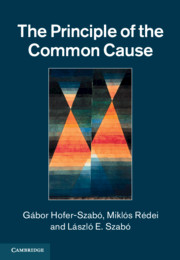Book contents
- Frontmatter
- Contents
- Preface
- 1 Introduction and overview
- 2 The Common Cause Principle
- 3 Common cause extendability of probability spaces
- 4 Causally closed probability theories
- 5 Common common causes
- 6 Common cause extendability of nonclassical probability spaces
- 7 Reichenbachian common cause systems
- 8 Causal closedness of quantum field theory
- 9 Reichenbach's Common Cause Principle and EPR correlations
- 10 Where do we stand?
- Appendix
- References
- Index
9 - Reichenbach's Common Cause Principle and EPR correlations
Published online by Cambridge University Press: 05 June 2013
- Frontmatter
- Contents
- Preface
- 1 Introduction and overview
- 2 The Common Cause Principle
- 3 Common cause extendability of probability spaces
- 4 Causally closed probability theories
- 5 Common common causes
- 6 Common cause extendability of nonclassical probability spaces
- 7 Reichenbachian common cause systems
- 8 Causal closedness of quantum field theory
- 9 Reichenbach's Common Cause Principle and EPR correlations
- 10 Where do we stand?
- Appendix
- References
- Index
Summary
Einstein-Podolsky-Rosen (EPR) correlations
Explaining the correlations predicted by quantum mechanics in the case of joint quantum systems of the EPR type has proved to be a major challenge for the Common Cause Principle. The EPR correlations have been confirmed by a large number of sophisticated experiments carried out since the early 1980s, and, since quantum theory does not give us any hints as to where to look for possible common causes that could explain the correlations in question, the suspicion arose that common causes of EPR correlations might not exist at all. If this were indeed the case, then the EPR correlations would constitute strong empirical evidence against Reichenbach's Common Cause Principle.
But how could this be possible in view of the results presented in the previous chapters? As we have seen (Chapter 3), every common cause incomplete probability space is common cause extendible (even strongly common cause extendible with respect to any finite set of correlations; Proposition 3.9); therefore every correlation can, in principle, be explained by a (possibly hidden) common cause, including the (finite number of) EPR correlations. Could the EPR correlations (not) be explained by referring to such hidden common causes?
To answer this question, one has to realize first that it is not quite obvious how to link the Common Cause Principle to quantum mechanics because Reichenbach's notion of common cause was defined in terms of classical probability theory (Chapter 2), not in terms of quantum probability theory.
- Type
- Chapter
- Information
- The Principle of the Common Cause , pp. 134 - 172Publisher: Cambridge University PressPrint publication year: 2013



